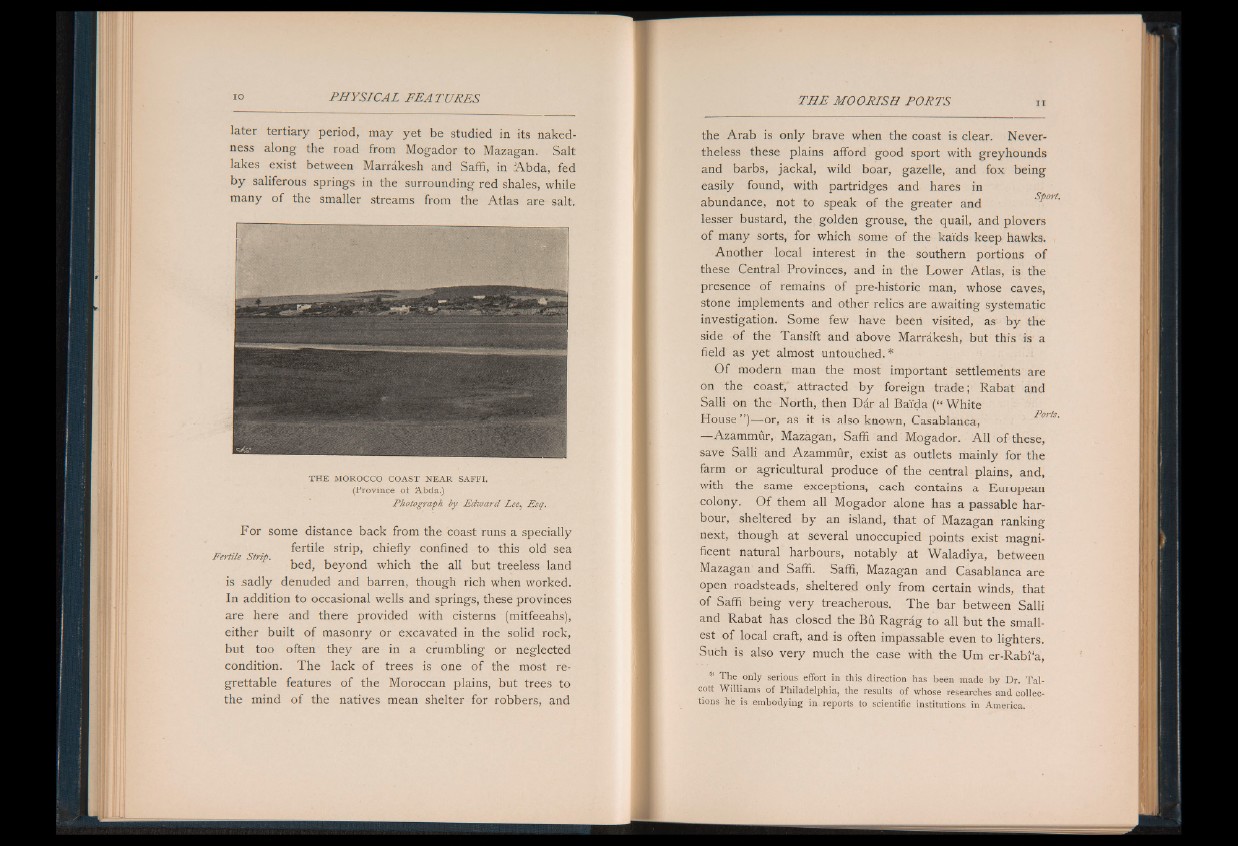
later tertiary period, may yet be studied in its nakedness
along the road from Mogador to Mazagan. Salt
lakes exist between Marrakesh and Saffi, in Abda, fed
by saliferous springs in the surrounding red shales, while
many of the smaller streams from the Atlas are salt.
TH E MOROCCO CO A ST N E A R SAFFI.
(Province of Abda.)
Photograph by Edward Lee. Esq.
For some distance back from the coast runs a specially
fertile strip, chiefly confined to this old sea
•rtile Strip. 1 1 . 1 1
bed, beyond which the all but treeless land
is sadly denuded and barren, though rich when worked.
In addition to occasional wells and springs, these provinces
are here and there provided with cisterns (mitfeeahs),
either built of masonry or excavated in the solid rock,
but too often they are in a crumbling or neglected
condition. The lack o f trees is one of the most regrettable
features o f the Moroccan plains, but trees to
the mind o f the natives mean shelter for robbers, and
the Arab is only brave when the coast is clear. Nevertheless
these plains afford good sport with greyhounds
and barbs, jackal, wild boar, gazelle, and fox being
easily found, with partridges and hares in
abundance, not to speak of the greater and
lesser bustard, the golden grouse, the quail, and plovers
of many sorts, for which some of the kai'ds keep hawks.
Another local interest in the southern portions of
these Central Provinces, and in the Lower Atlas, is the
presence of remains of pre-historic man, whose caves,
stone implements and other relics are awaiting systematic
investigation. Some few have been visited, as by the
side of the Tansift and above Marrakesh, but this is a
field as yet almost untouched.*
Of modern man the most important settlements are
on the coast,' attracted by foreign trade; Rabat and
Salli on the North, then Dar al Baida (“ White
House ”)— or, as it is also known, Casablanca,
— Azammur, Mazagan, Saffi and Mogador. A ll of these,
save Salli and Azammur, exist as outlets mainly for the
farm or agricultural produce of the central plains, and,
with the same exceptions, each contains a European
colony. O f them all Mogador alone has a passable harbour
, sheltered by an island, that o f Mazagan ranking
next, though at several unoccupied points exist magnificent
natural harbours, notably at Waladiya, between
Mazagan and Saffi. Saffi, Mazagan and Casablanca are
open roadsteads, sheltered only from certain winds, that
of Saffi being very treacherous. The bar between Salli
and Rabat has closed the Bu Ragrag to all but the smallest
of local craft, and is often impassable even to lighters.
Such is also very much the case with the Um er-Rabi‘a,
* The only serious effort in this direction has been made by Dr. Tal-
cott Williams of Philadelphia, the results of whose researches and collections
he is embodying in reports to scientific institutions in America.